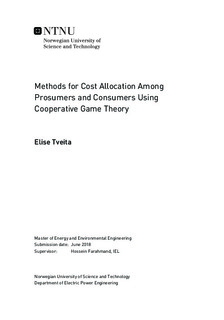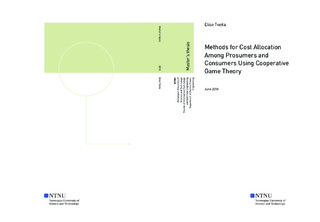| dc.description.abstract | The decarbonization of the power sector is at the core of the transition to a sustainable energy future. In parallel with the growth in renewables, the costs of solar photovoltaic (PV) and electrical energy storage (EES) are decreasing, which facilitates installation of these devices at the residential level. With a higher penetration of distributed generation (DG) and electrical energy storage (EES), private end-users are taking a more active role in the power grid. Currently, independent operation of these devices is most common. With an increased amount of DG and EES available, opportunities for cooperation through power exchanges arise. In cooperative game theory, all play- ers cooperate under joint benefits. Preliminary studies conducted by the author, show that such cooperation among prosumers and consumers yields reduced annual electricity cost compared to independent operation.
Focusing on cost allocation among end-users equipped with rooftop PV and batteries, the objective of this thesis is to analyze two possible solution concepts; the nucleolus and the Shapley value. An energy community consisting of private end-users is modeled as a cooperative game. By changing parameters that increase the value of the battery system in terms of reduced cost, this thesis aims to examine whether the deviation between the cost allocation methods increases as the value of the battery system is changed. The simulated energy community is based on data from private residences in Norway, provided by Trønderenergi Nett, the local distribution system operator (DSO).
Results show that both nucleolus and the Shapley value provide stable cost allocations under minor deviations, depending on the case. Results also show that the deviation between the methods increases, as the value of the battery system increases. The highest deviation between the methods is of 3 %. In this scenario, the value of the battery system is 8.84 %, which also represents the highest value of batteries within the considered scenarios. | |

